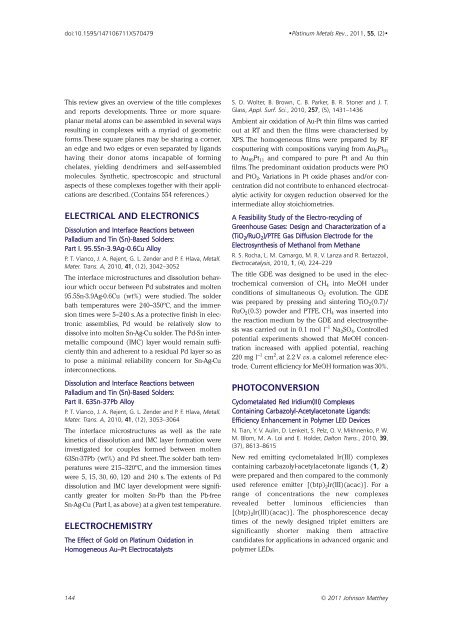Download - Platinum Metals Review
Download - Platinum Metals Review
Download - Platinum Metals Review
You also want an ePaper? Increase the reach of your titles
YUMPU automatically turns print PDFs into web optimized ePapers that Google loves.
doi:10.1595/147106711X570479<br />
•<strong>Platinum</strong> <strong>Metals</strong> Rev., 2011, 55, (2)•<br />
This review gives an overview of the title complexes<br />
and reports developments. Three or more squareplanar<br />
metal atoms can be assembled in several ways<br />
resulting in complexes with a myriad of geometric<br />
forms.These square planes may be sharing a corner,<br />
an edge and two edges or even separated by ligands<br />
having their donor atoms incapable of forming<br />
chelates, yielding dendrimers and self-assembled<br />
molecules. Synthetic, spectroscopic and structural<br />
aspects of these complexes together with their applications<br />
are described. (Contains 554 references.)<br />
ELECTRICAL AND ELECTRONICS<br />
Dissolution and Interface Reactions between<br />
Palladium and Tin (Sn)-Based Solders:<br />
Part I. 95.5Sn-3.9Ag-0.6Cu Alloy<br />
P. T. Vianco, J. A. Rejent, G. L. Zender and P. F. Hlava, Metall.<br />
Mater. Trans. A, 2010, 41, (12), 3042–3052<br />
The interface microstructures and dissolution behaviour<br />
which occur between Pd substrates and molten<br />
95.5Sn-3.9Ag-0.6Cu (wt%) were studied. The solder<br />
bath temperatures were 240–350ºC, and the immersion<br />
times were 5–240 s.As a protective finish in electronic<br />
assemblies, Pd would be relatively slow to<br />
dissolve into molten Sn-Ag-Cu solder. The Pd-Sn intermetallic<br />
compound (IMC) layer would remain sufficiently<br />
thin and adherent to a residual Pd layer so as<br />
to pose a minimal reliability concern for Sn-Ag-Cu<br />
interconnections.<br />
Dissolution and Interface Reactions between<br />
Palladium and Tin (Sn)-Based Solders:<br />
Part II. 63Sn-37Pb Alloy<br />
P. T. Vianco, J. A. Rejent, G. L. Zender and P. F. Hlava, Metall.<br />
Mater. Trans. A, 2010, 41, (12), 3053–3064<br />
The interface microstructures as well as the rate<br />
kinetics of dissolution and IMC layer formation were<br />
investigated for couples formed between molten<br />
63Sn-37Pb (wt%) and Pd sheet. The solder bath temperatures<br />
were 215–320ºC, and the immersion times<br />
were 5, 15, 30, 60, 120 and 240 s. The extents of Pd<br />
dissolution and IMC layer development were significantly<br />
greater for molten Sn-Pb than the Pb-free<br />
Sn-Ag-Cu (Part I, as above) at a given test temperature.<br />
ELECTROCHEMISTRY<br />
The Effect of Gold on <strong>Platinum</strong> Oxidation in<br />
Homogeneous Au–Pt Electrocatalysts<br />
S. D. Wolter, B. Brown, C. B. Parker, B. R. Stoner and J. T.<br />
Glass, Appl. Surf. Sci., 2010, 257, (5), 1431–1436<br />
Ambient air oxidation of Au-Pt thin films was carried<br />
out at RT and then the films were characterised by<br />
XPS. The homogeneous films were prepared by RF<br />
cosputtering with compositions varying from Au 9 Pt 91<br />
to Au 89 Pt 11 and compared to pure Pt and Au thin<br />
films. The predominant oxidation products were PtO<br />
and PtO 2 . Variations in Pt oxide phases and/or concentration<br />
did not contribute to enhanced electrocatalytic<br />
activity for oxygen reduction observed for the<br />
intermediate alloy stoichiometries.<br />
A Feasibility Study of the Electro-recycling of<br />
Greenhouse Gases: Design and Characterization of a<br />
(TiO 2 /RuO 2 )/PTFE Gas Diffusion Electrode for the<br />
Electrosynthesis of Methanol from Methane<br />
R. S. Rocha, L. M. Camargo, M. R. V. Lanza and R. Bertazzoli,<br />
Electrocatalysis, 2010, 1, (4), 224–229<br />
The title GDE was designed to be used in the electrochemical<br />
conversion of CH 4 into MeOH under<br />
conditions of simultaneous O 2 evolution. The GDE<br />
was prepared by pressing and sintering TiO 2 (0.7)/<br />
RuO 2 (0.3) powder and PTFE. CH 4 was inserted into<br />
the reaction medium by the GDE and electrosynthesis<br />
was carried out in 0.1 mol l –1 Na 2 SO 4 . Controlled<br />
potential experiments showed that MeOH concentration<br />
increased with applied potential, reaching<br />
220 mg l –1 cm 2 ,at 2.2V vs. a calomel reference electrode.<br />
Current efficiency for MeOH formation was 30%.<br />
PHOTOCONVERSION<br />
Cyclometalated Red Iridium(III) Complexes<br />
Containing Carbazolyl-Acetylacetonate Ligands:<br />
Efficiency Enhancement in Polymer LED Devices<br />
N. Tian, Y. V. Aulin, D. Lenkeit, S. Pelz, O. V. Mikhnenko, P. W.<br />
M. Blom, M. A. Loi and E. Holder, Dalton Trans., 2010, 39,<br />
(37), 8613–8615<br />
New red emitting cyclometalated Ir(III) complexes<br />
containing carbazolyl-acetylacetonate ligands (1, 2)<br />
were prepared and then compared to the commonly<br />
used reference emitter [(btp) 2 Ir(III)(acac)]. For a<br />
range of concentrations the new complexes<br />
revealed better luminous efficiencies than<br />
[(btp) 2 Ir(III)(acac)]. The phosphorescence decay<br />
times of the newly designed triplet emitters are<br />
significantly shorter making them attractive<br />
candidates for applications in advanced organic and<br />
polymer LEDs.<br />
144 © 2011 Johnson Matthey
















